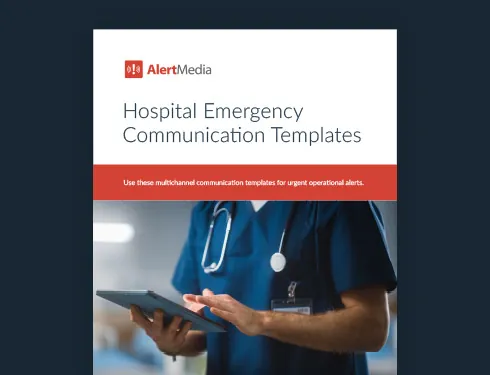![Risk Management in Healthcare: From Plan to Action [+ Communication Templates]](https://www.alertmedia.com/wp-content/uploads/2023/03/Blog-RiskMgmt-Healthcare-v2a-1024x536.jpg)
Risk Management in Healthcare: From Plan to Action [+ Communication Templates]
When lives are at stake, you can’t afford to ignore your organization’s risks. Learn what risk management looks like in healthcare and how to plan ahead to manage it.

Risk is a natural part of any enterprise. But in the world of healthcare, risks are high and pervasive. Threats to both patients and staff are a reality you must account for, or there will be avoidable accidents, injuries, and even loss of life.
The stakes are simply too high to leave your risk management up to chance. Understanding your facility’s risk profile and building out a management and mitigation plan are necessary steps every healthcare organization must take to stay functional and protect the very people they are designed to help. Follow this guide to help you get there.
Download Our Hospital Emergency Communication Templates
What Is Risk Management in Healthcare?
Risk management in healthcare is the process of identifying, monitoring, and mitigating risk through different administrative and clinical procedures in order to prevent adverse events or harm. Historically, risk management in healthcare has focused on risks to patient health, such as medical errors. But there is an emerging shift in the industry toward a holistic perspective of risk as it relates to the entire organization. This is known as enterprise risk management.
What is enterprise risk management (ERM)?
Enterprise risk management in healthcare is the same as standard risk management, but it applies more broadly to all the areas of risk that a healthcare organization faces. It’s about more than just patient care. It’s also about how risk might affect the entire organization, including disruptions to operational uptime and efforts to minimize costs. For example, while traditional risk management programs might work to mitigate the risk of mistakenly administering a medication a patient is allergic to, enterprise risk management programs account for these and broader threats, such as the risk of a cybersecurity breach that leaks confidential information.
Hospital risk management example
One great example of risk management is Valley View Hospital’s navigation of vaccine distribution in 2020. When the hospital first received its vaccines, there were several vulnerable areas that needed to be managed, such as the widespread risk of infection, staffing shortage risks, and the risks of losing critical vaccine doses by not administering them. These challenges added to the “normal” environmental risks the staff is already dealing with every day in their disaster-prone hospital location.
The hospital used comprehensive communication to develop a fluid operation that allowed them to schedule vaccination appointments and send reminders with ease. They could efficiently check people in, screen them for allergies, and administer a vaccine in just a matter of minutes—thus mitigating many of the risks surrounding vaccine distribution.
“We started by vaccinating our employees, but our model was so strong that we’ve taken the lead in our county. Our average throughput time is two minutes and 30 seconds,” said Josh Anderson, Valley View’s Manager of Safety, Security, and Emergency Management. “This allows us to vaccinate not only our employees, but also other healthcare workers, teachers, smaller organizations, and private practices.” With good communication as a core risk management strategy, Valley View was able to effectively serve their community and protect their patients, staff, and organization from harm.
Proactive vs reactive risk management
The key to effective risk management is thinking beyond risk response. If your organization takes a reactionary stance, you’ll be constantly playing catch-up with threats. Instead, think of your risk management from a proactive perspective. Look for what risks you might face and create an action plan to address them before things go wrong. This approach requires you to be looking and planning ahead, so keep reading for more tips on how to build out your risk management plan for a healthcare setting.
What Is at Stake With Poor Risk Management?
The aim of risk management is to lower and prevent risk. Specifically, there are three areas that are vulnerable if you don’t implement the healthcare risk management process effectively.
- Patient safety: Simply put, if you don’t manage risks, your patients’ lives are at stake. Ensuring effective and safe patient care requires protective measures. This isn’t because care providers are trying to do harm but because accidents, mix-ups, and mistakes are inherent risks in the healthcare industry.
- Staff welfare & retention: The healthcare providers and staff members themselves are also under threat of poor risk management. Staff may suffer from physical health risks like injury or infection, mental health struggles, increased legal trouble from medical malpractice, and increased turnover or performance due to strenuous conditions. It is up to the organization to protect its employees by managing risk in the facility.
- Organization liability & function: The stakes for the facility can range from increased legal liability and lawsuits to failing a Joint Commission survey and losing accreditation or certifications. Without risk management from an enterprise level, the overall function of a healthcare facility will falter.
We established that an enterprise risk management framework is a “holistic” approach to addressing risk in your organization. But what exactly does that mean? There are eight different types of risks a healthcare facility will need to manage:
- Operational (training and procedures)
- Clinical and patient safety (medical errors)
- Strategic (brand and reputation)
- Financial (litigation costs and profit)
- Human capital (understaffing and employee injuries)
- Legal and regulatory (compliance and accreditation)
- Technological (cyberattacks and patient data)
- Environmental and infrastructure (natural disasters, security, and facilities issues)
Your risk management plan should account for all these areas of risk and create strategies for risk mitigation in each case. One way to cover all the bases is to use the all-hazards approach, which accounts for the range of hazards without the need to build individual responses to each specific risk. Another option is using the five-step risk management lifecycle, which is a structured approach to handle unseen risks and threats across various locations at scale.
How to Develop a Healthcare Risk Management Plan
It’s nearly impossible to manage or mitigate potential risks without a plan in place. Here are the steps you can take to create your risk management plan so that your healthcare organization is able to operate safely, no matter what happens.
1. Establish the context: Clarify the scope of your organization before jumping into your risk identification. Take a look at your location, size, and situation. Here are some questions to ask:
- How many employees do you have?
- What accreditations or certifications do you have?
- What does your standard patient flow look like?
- Who are your organization’s key stakeholders?

2. Identify the risks: Next, dedicate ample time for identifying risks your location might face. This process will help you determine what you need to prepare for. Consider all of the threats that fall under the areas of risk listed above. Here are a few examples:
- Mismanaged medical records
- Hazardous materials spill
- Ransomware attack
- Incorrect prescription
- Understaffing in an overcrowded ward
3. Measure/analyze the risk: Take the time to analyze how often this risk might occur and how bad it could be if it does happen. Take the time to break down the specifics and get an idea of what it might take to manage each particular risk. You can do this by looking through past experiences, for example taking a recent sentinel event and performing a root-cause analysis to understand what happened.
4. Mitigate the risk: Finally, it’s time to make plans for mitigation and management. Reference CMS emergency preparedness guidelines and other regulations you may be subject to. This might mean implementing more training, adding steps to already-established safety procedures, or even just reminding staff members about their safety processes regularly by building in safety moments to each shift.
5. Communicating your plan: The most thorough plan doesn’t work if nobody on your team knows how to follow it. Make sure you have a way to communicate about your risk management solutions. Using a two-way notification system is a great way to create an open feedback loop about relevant or active risks with your on-the-ground team members. You can also improve communication in healthcare spaces by leveraging notification templates to alert everyone when a risk has become a legitimate threat.
Risk management tools in healthcare
There are several tools you can lean on to build out this plan at every stage. Here are some to get you started and prepare your team to act.
- Risk assessment: Identify and evaluate your organization’s risks
- Risk matrix: Analyze the probability and impact of risk
- Compliance assessments: Determine if your organization is meeting accredited standards
- After-action reports: Learn from training drills and real safety incidents
- Tabletop exercises: Practice high-stakes emergency response in a low-stakes environment
Managing Patient Safety and More
Patient safety is at the center of everything in the healthcare industry. But there is a whole other side to risk management you need to plan for. The best way to keep everyone safe and your whole organization running smoothly is to integrate a comprehensive risk management system and lean on reliable communication software to help you. AlertMedia is the go-to mass notification solution for leading healthcare organizations around the world. To learn more about how we can help you manage your risk, schedule a demo today.





